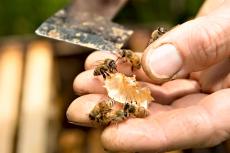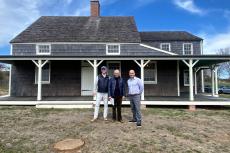While recent downpours have already pushed August rainfall totals past the monthly average, maintaining the health of Long Island’s aquifer is a long game. In fact, despite recent rains, as of Aug. 8, Suffolk County was still ranked “abnormally dry” by the United States Drought Monitor. Nassau County was still in “moderate drought.”
How dry is that? Well, Maui was in “moderate drought” before its recent wildfires.
Better use of the aquifer, and an appreciation of it as an existential resource, could help mitigate the vicissitudes of nature, and the Suffolk County Water Authority is at work on both fronts.
“We are extremely fortunate to have this aquifer,” said Jeffrey Szabo, chief executive officer of the water authority, which operates about 600 wells across the county. “In New York City and upstate it’s reservoirs, it’s lakes. This aquifer is unique.” He said the authority set aside $250,000 in 2023 purely for conservation messaging.
“That was the first time we’ve done something like that. We’ve used traditional means to contact residents before through our website, social media, and their bills. But this initiative to ramp up dialogue about conservation is new,” he said.
Also new is a third pricing tier that Mr. Szabo hopes to introduce in the coming months that would create a higher rate for “superusers,” as yet undefined but something like the top 1 percent, of which the South Fork has many. “You get more bang for the buck targeting superusers and educating them. Many want to do the right thing. If they’re informed, I think you may see a change in habits.”
“We have property owners that dramatically impact our system, using millions of gallons a year for irrigation and for geothermal heating systems that put tremendous stress on our ability to meet need.” For example, a 10,000-square-foot house using a geothermal system year round could use over 20 million gallons of water. That said, Mr. Szabo estimates about 70 percent of use during the summer months comes from irrigation systems.
Some of the other S.C.W.A. measures seem quaint in the face of the superusers’ demands on the system. The average S.C.W.A. customer uses 130,000 to 150,000 gallons a year in their kitchen, bathroom, and on their lawns. In February the board voted for odd/even watering, and it has also approved several rebates for water conservation devices.
There are signs that the message is beginning to seep through.
Ben Gregor, who with his family has run Gregor Well Drilling of Hampton Bays since 1974, said that since the names of some of the superusers on the East End were published last summer, he has converted several “open-loop” geothermal systems to “closed-loop” systems.
In July of 2020, the water authority voted to no longer approve applications for water service that use open-loop systems, based on a recommendation from the Long Island Commission for Aquifer protection.
“Open-loop systems are the biggest users of water,” Mr. Gregor said via text. Such a system “takes water out of the ground, runs it through pipes, and then injects it back into the ground. Closed-loop circulates the same water continuously through a series of loops in the ground. Houses near the water generally have water quality issues, and that’s why they were using town [public] water, before it was against the rules,” he said.
That’s not to say that someone with an open-loop system couldn’t drill their own private well to access the groundwater. That’s is exactly what Howard Marks, who owns a house on Tyson Lane in Amagansett, has done.
“They acquired the property in 2019, and over the course of two seasons realized their water usage was very high,” said Linda Margolin, an attorney speaking for Mr. Marks. “The air-conditioning system relied on geothermal cooling and they were taking potable water from” the water authority’s public supply. “Last year they sunk two wells and reconfigured the system, so it no longer relies on the S.C.W.A. They expect it will cut water usage by 50 percent,” she said.
“It was an affirmative voluntary action to not be a problem with respect to these uses of water that don’t need the quality of public water that S.C.W.A. gives residents,” she said.
Mr. Szabo acknowledged that “a private open-loop system is better than an open-loop connected to public supply,” but said that while “opting for a private well for open-loop systems would lessen the burden on the public system . . . it will not help the long-term supply of the aquifer overall.”
According to the United States Geological Survey, Long Islanders draw 400 million gallons per day from the aquifer. We rarely consider it: You turn on the faucet, you flush the toilet, you irrigate your grass, and the water is there. Where the water comes from, how much is left, and how clean it is, is taken for granted.
The surface of the Island — its golf courses, backyards, even the Long Island Expressway — basically acts as the first layer of a filter that rainwater interacts with on its journey through the soil and into the aquifer, recharging it over time. How long that recharge takes varies across the Island. But if the aquifer is pumped too aggressively, it can impact lakes and wetlands, or lead to saltwater intrusion. And if that filter is full of pesticides and nitrogen from septic waste, our drinking water is impacted.
“There’s a role that each of us play in the long-term preservation of the aquifer,” said Mr. Szabo. “We’re proud of the steps we’ve taken, but there’s more that we can do.”




